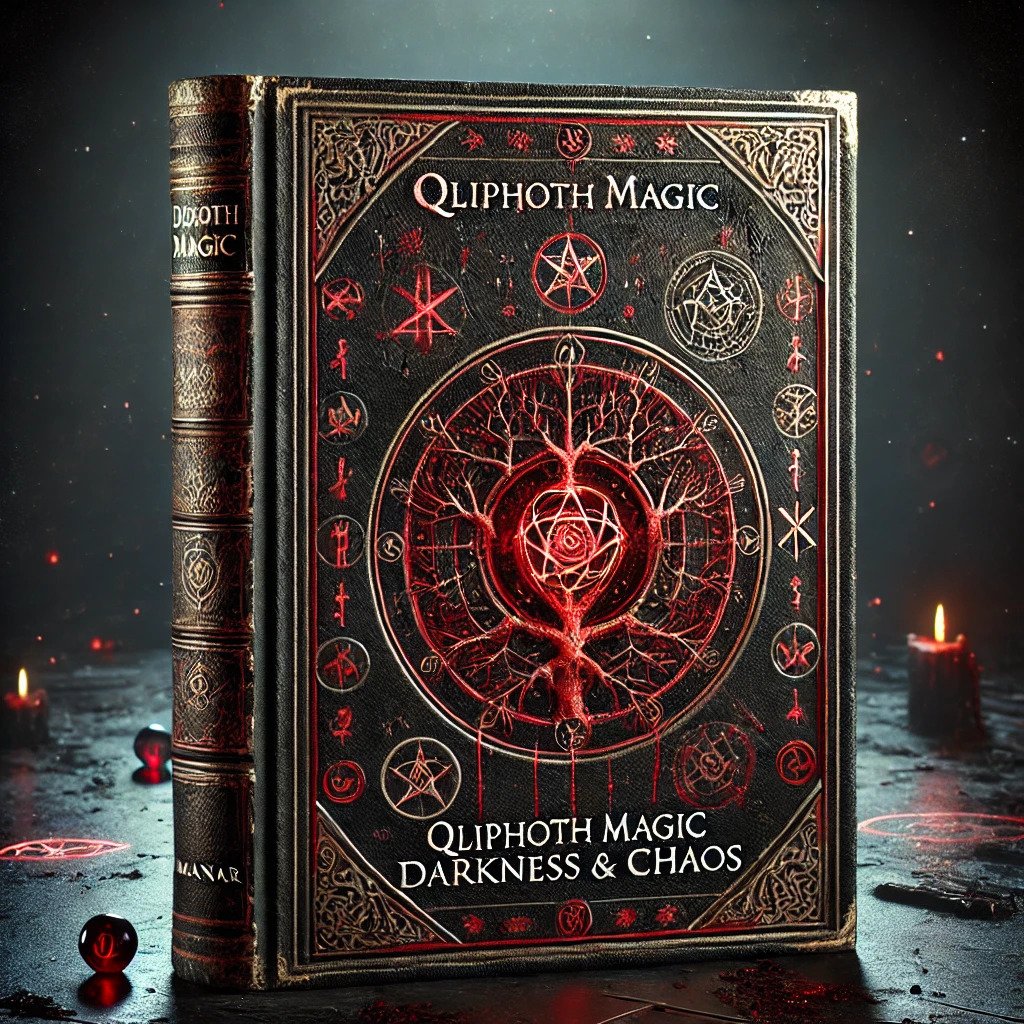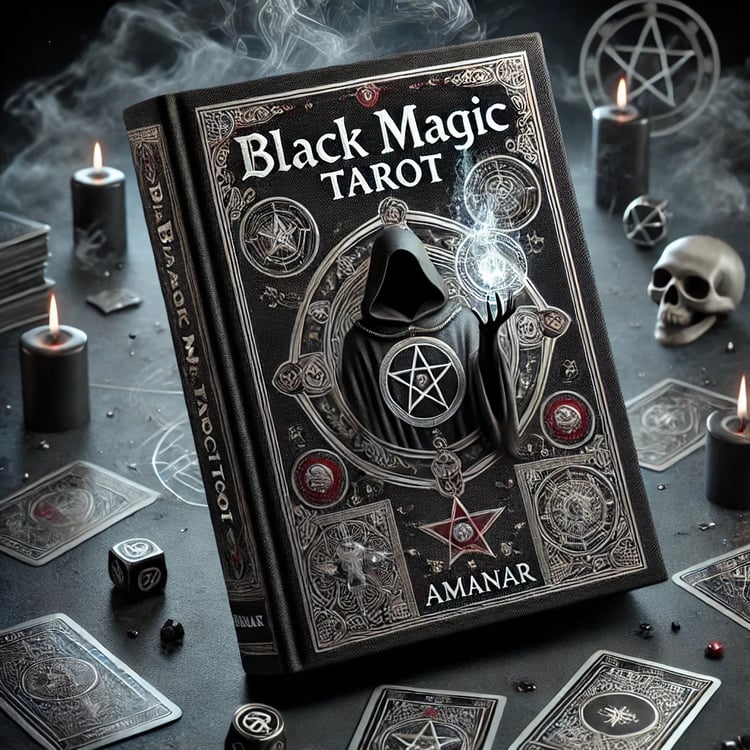
Amanar "Qliphoth, Darkness, and Chaos Magic"
1. The Hidden Paths of the Qliphoth
In this chapter, we shall traverse the gateways of forbidden knowledge that lie beyond the familiar realms of the Sefirot, unveiling the veiled passages into the Qliphothic spheres. Through tales of ancient Kabbalists and renegade sorcerers, the reader will discover how the power of darkness weaves through the broken husks of creation. In solemn paragraphs reminiscent of the old grimoires, we will introduce the arcane significance of each Qliphothic shell, recounting whispers of banished gods and their relevance to the modern practitioner. From the cryptic names in Latin manuscripts to the echoing rhythms of Sumerian incantations, these revelations will prepare the soul for the deeper abyssal works that follow.
2. Invocation of Primordial Night
This chapter delves into the primal forces of night that predate mortal comprehension, revealing how these energies may be invoked and harnessed through moonlit ceremonies and sacred chants in unknown tongues. Drawing from medieval witchcraft, Voodoo traditions, and the fragments of Babylonian conjurations, the text elaborates upon the methods of calling forth the spirits of nocturnal power. Readers shall glimpse the surge of living darkness beneath the surface of ritual acts, guided by testimonies from ancient wanderers who claimed to have touched the essence of cosmic shadows.
3. The Anatomy of Ritual Vessels
Here, we examine the essential tools and vessels of the mage, from the iron cauldron and the battered chalice to the waxen sigils that enfold spirit-essences. The teachings of European covens mingle with the murmurings of Egyptian shadow-lore, emphasizing the vital nature of properly forged implements. Each paragraph unveils further mysteries of craftsmanship, showing how the alignment of material and purpose may enhance or hinder the ambitions of the adept, all the while tracing the lineage of such instruments through centuries of occult practice.
4. Blood, Bone, and the Essence of Sacrifice
In this offering to the dread powers, we explore the ancient laws of sacrifice, where blood and bone hold potency as vessels of both creation and destruction. The text unveils the guarded secrets of old witch-clans, who once invoked the spirits of swamp and cemetery using offerings of flesh and fluid. A medley of Haitian Voodoo rites and Hebrew mystic lore interweaves, illustrating the delicate balance of transgression and veneration. Readers are guided through murky traditions wherein life force is bartered for arcane gifts, underscoring the ethical and spiritual weight of every such transaction.
5. Conjuration of Abyssal Lords
The Qliphothic grimoires speak of beings that dwell at the edges of existence, known by many as Abyssal Lords. These spirits, invoked through cryptic phrases in Latin and through the resonant echoes of ancient Sumerian, govern the turmoil of chaos and darkness. In hushed paragraphs, we uncover the protocols for summoning these formidable entities, the warnings inscribed by lone mystics, and the transformative boons—yet also perils—they bestow upon those who dare call their names. Within these lines, the mage will learn the labyrinth of negotiations required to forge alliances with such powers.
6. The Serpent’s Dream: Visions of the Otherworld
Turning inward, we explore the labyrinth of altered states through which the sorcerer may behold the realms beyond mortal vision. This chapter recounts archaic potions brewed from poisonous flora, incenses crafted from rare resins, and the methodical chanting used to part the veil of conventional sight. The old scribes wrote of serpentine dreams that lead the practitioner into caverns of revelation, where hidden watchers whisper truths in unknown tongues. Using fragments of Celtic witch-lore and echoes of Egyptian astral texts, we traverse the boundaries of mind and spirit.
7. Seals, Sigils, and Cryptic Symbols
In ancient scrolls and codices, one finds the intricate art of sigil creation, a practice bridging every known magical tradition. This chapter explores how to craft potent seals that focus the will, from geometric lines to half-familiar glyphs that evoke names best left unspoken. Through absorbing accounts of Renaissance magicians and glimpses of African symbolic rites, the text guides the reader to unify theory with craft. Each line hints at labyrinthine mysteries, teaching the importance of secrecy, discipline, and unwavering intent when fashioning or charging these occult designs.
8. The Hierarchy of Shadow Servitors
Scholars of the hidden arts once compiled elaborate charts of lesser spirits, devils, and shades, ranking them according to dread authority. In this portion, we study the roles such servitors fulfill in the mage’s quest, from watchers of forbidden thresholds to cunning messengers of the underworld. By weaving together Kabbalistic writings on the husks of creation with the lore of cunning folk across Europe, we expose the labyrinthine ties between these shadowy denizens. The text recalls the cautionary sagas of those who lost their way in forging pacts with insubordinate spirits.
9. The Witch’s Sabbath and the Dark Feast
Here, the ancient gatherings of witches beneath moon and star are revealed in all their fearsome splendor, recounting the delirious revelries of times past. This chapter offers an inside perspective on the rites performed at these clandestine festivals—the potent concoctions, the secret names of living shadows, and the dancing flames that conjure midnight’s power. The text draws from local folk traditions, testimonies from persecuted sorcerers, and fragmentary records gleaned from inquisitorial archives. Within these passages lie insights into the primal unity of magic and revelry, danger and ecstasy.
10. Crafting the Talismanic Heart of Darkness
Focused on the creation and consecration of talismans, this chapter wanders through the labyrinthine techniques once safeguarded by cunning men and cunning women. By calling upon the infernal tongues of antiquity and the deep chants of subterranean temples, one may forge an artifact that pulses with the currents of Qliphothic energy. Drawing from the seldom-spoken works of necromantic Kabbalists, the text breathes new life into the lost arts of binding essences within metal, bone, or precious stone. Readers are guided to awaken in these objects the beating heart of darkness itself.
11. Mastery of the Four Elements in the Shadow Realms
The classical elements—Earth, Air, Fire, and Water—serve as pillars of the craft, yet they embody different faces when seen through the prism of the Qliphoth. This section reveals how to manipulate their dark reflections, from the conjuration of storms through corrupted winds, to the forging of cursed flames. Drawing upon archaic European spells and remnants of Sumerian elemental worship, each paragraph conveys lessons in harnessing these forces with caution, for the path of the Qliphoth inverts as easily as it empowers. In these words, the adept learns the delicate dance of dominion over matter and spirit alike.
12. The Keys of Infernal Alchemy
Turning to the transmutation of body and soul, we survey the arcane processes by which the practitioner may refine their inner essence. The texts speak of blackened elixirs, brewed in stone vessels under the watchful eyes of spectral guardians, capable of unlocking hidden potential or unleashing the chthonic energies that lurk within. Borrowing from the tomes of clandestine European alchemists and the rhythmic chants of African root-workers, this chapter shows how to merge physical and spiritual matter, forging a path toward an occult metamorphosis that transcends ordinary life.
13. Lunar Sorceries and the Ebb of Tidal Power
Night belongs to the moon and those who serve her mystical phases, for each lunar cycle may govern distinct channels of enchantment. In this portion, we explore the age-old rituals aligned with waxing and waning energies, from summoning illusions beneath a full moon to whispering dire curses in the gloom of a moonless sky. Old sagas and hidden diaries illustrate the synergy between ocean tides and cosmic rhythms, unveiling how wise witches once called upon these forces to blur the lines between worlds. Through dreamscapes of watery reflection and shimmering midnight spells, the moon’s dominion is laid bare.
14. The Gateway of the Tomb: Necromantic Practices
To walk among the dead is to court the final mystery of existence. Within these pages, we open the gate to necromancy, unveiling funerary rites from ancient Greece and the crypt-wisdom of medieval sorcerers. Arcane formulae, once whispered by the faithful of Voodoo pantheons, intertwine with the hushed speech of Kabbalistic grave-works. The text portrays how to stir the restless spirits for counsel or conjure them to serve your command, offering caution that to do so invites perilous consequences. In paragraphs reminiscent of tomb inscriptions, the necromancer’s art is revealed in its somber gravity.
15. The Great Work of Chaos and Creation
Venturing deeper, we confront the primal chasm where chaos births and devours all. This part of the text addresses the paradoxical nature of chaos magic, taking the illusions of form and unraveling them in order to mold new realities. References to half-burned manuscripts and confessions from the hermetic enclaves show how the might of pure potential may be woven into ritual praxis. Through improvised sigils, spontaneous invocations, and the relentless focus of will, the adept learns to shape the swirling dark into a brand of creation that defies every known law.
16. The Crown of Shadows: Ascending the Qliphothic Tree
Here, we set forth upon the perilous ascent of the Qliphothic Tree, stepping shell by shell through tangled illusions. Each step tests the sorcerer’s conviction, forcing confrontations with hidden fears, obsessions, and illusions that dwell within. Blending commentary from rebellious Kabbalists and the cryptic scrawl of excommunicated priests, this chapter serves as a guide, illuminating both the grandeur and the terrifying isolation of the darkest heights. For one who claims this crown of shadows shall never again walk among mortals unchanged.
17. Echoes of the Ancestral Witch-Fires
Generations of witches have preserved their legacy through oral lore, passing spells and revelations from grandmother to child in secret corners of the hearth. Within these pages, we recite the whispered recollections of old fireside gatherings, telling of potions brewed by starlight, of whispered blessings entangled with curses, and the unwavering bond between the living and those who have crossed into the land of spirits. From the ash-laden floors of Germanic cottages to the hidden enclaves of Scottish moorlands, we glean the timeless wisdom of folk cunning and devotion to unseen realms.
18. The Rite of the Unsealed Grimoire
No book of magic stands complete until it is ritually awakened, and thus we arrive at the unveiling of the tome itself. This chapter gives voice to the seldom-discussed act of sealing and unsealing grimoires, anointing them with drops of the writer’s own lifeblood, saturating them in incenses whose names echo from Sumer and Nineveh. Through recollections of archaic libraries and forbidden archives, the text guides the aspirant to commune with the living essence of the written word, forging a bond that endures beyond mortal confines. In the hush of lamplight, the pages themselves become a portal to the unknown.
19. Paths of the Hex and the Curse
Delving into the more malefic shades of magic, this section illuminates how hexes and curses have been cast throughout the ages. Drawing on transcripts of medieval trials, Haitian conjure traditions, and the black-lipped invocations of Heretical Cabalists, we delve into the incantations and incenses that can bind, afflict, or bring ruin upon the chosen target. These paragraphs caution the reader about the inevitable repercussions of such workings, emphasizing that every strand of malevolent magic weaves a double edge, where the conjurer risks ensnaring themselves in the web of their own creation.
20. Enlightenment through Darkness: The Hermit’s Passage
Even within the gloom of the Qliphoth, a hidden light may emerge, guiding the stalwart seeker to profound revelation. Here, we reflect on the philosophy of facing one’s personal darkness and harnessing it as a catalyst for growth. Stories from ascetic desert mystics and solitary witch-clans are woven together with Gnostic musings on the spark within. The text reveals how, by enduring the crucible of isolation and the silent gnosis of night, the adept can forge a new spiritual identity, tempered in the fires of adversity and crowned in the hush of inner revelation.
21. Banishing the Night’s Abyss
Before the final chord is struck, the mage must learn to dispel the amassed currents of shadow and sever the ties with all summoned powers. In time-honored paragraphs reminiscent of the earliest manuscripts of exorcists and cunning folk, this chapter details the rites of purification and banishment, ensuring that no lingering presence or unbound force shall remain at the close of the work. Through candlelit prayers in obscure tongues and the scattering of sanctified salt, we guard against the hungry spirits of chaos. By the last syllable of this portion, the practitioner has the keys to seal every door once opened.
22. The Final Illumination: Wisdom Beyond the Veil
Concluding this tome, we gather all threads woven throughout the chapters into one tapestry of dark wisdom. This culminating section reflects upon the trials endured, the spirits encountered, and the transformations that have forever altered the inner realm of the aspiring sorcerer. Here, echoes of archaic incantations blend with the solemn hush of Kabbalistic insights, affirming that the ultimate purpose of shadow magic is not destruction alone but the forging of new vision through embracing the depths. The reader is left at the threshold, awakened to the infinite labyrinth of possibilities in the boundless interplay of light and darkness.
Amanar










